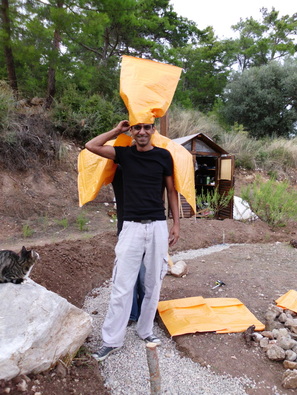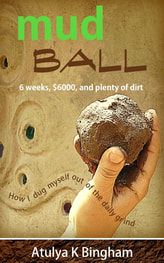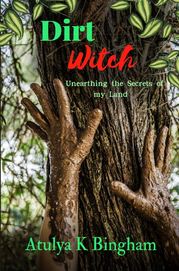The sacks
 Adnan demonstrating the many uses of polypropylene sacks.
Adnan demonstrating the many uses of polypropylene sacks.
Yes, I have railed against concrete. But lest anyone think I’m an environmental purist, let’s talk about the not so green aspect of earthbag building. What about those polypropylene bags? You may ask. Aren’t they just as bad as using concrete?
Honestly, if I had had eons of time to learn cob, plenty of money and didn't live slap bang on a major earthquake fault which experiences hefty bouts of sudden flooding, I’d love a cob home. They are as natural as it gets, I would never deny it.
But the bottom line is, when it comes to earthquakes and flash flooding, earthbag is king. It’s invincible. Even Ianto Evans, whose fantastic cob book I recommend, doesn't advise building a cob home on a flood plain. It can collapse on you.
Take a look at what happened in Nepal, where earthbag has proved itself far more sustainable and durable than local mud brick homes.
Whatever type of home you build, you will have an effect upon your environment. You will have to make decisions and weigh up environmental impact, strength of structure, climatic considerations and personal health issues (for example, I'm allergic to straw and cannot work with it for long periods of time). If you don’t have suitable earth to create cob, you’re going to have to ship it in. The same goes for strawbale. Where did the bales come from? Did you coat them in chemicals to stop them rotting? And how were they brought to your land. By truck? Using fossil fuels? Yeeees . . .
The more you study it, the less simplistic you become.
Earthbag building usually utilises polypropylene sacks. Not great, you might say. But for me, if you’re going to use polypropylene for anything, use it in a house that will stand a lifetime, shelter you in a quake and keep you safe in a severe flood. It’s not like drinking from a plastic water bottle and lobbing it in the bin after 5 minutes use.
What is polypropylene exactly?
Polypropylene is a type of thermoplastic polymer resin. It's lightweight, flexible and doesn't contain BPA, the carcinogenic nasty that leaches into food. It also doesn't mold when wet (important if you live in a damp climate). But ultimately it's still plastic. I have as much aversion to plastic as I do concrete. The only difference between the two is this; concrete is completely unnecessary. It brings nothing to your construction other than damp and ugliness. Plastic will be too if the world ever wakes up and alternatives like hemp are more readily available.
Alternatives to polypropylene bags
Burlap bags are a great alternative to PP, though beware, they are also not as natural as they first appear. Most are treated with hydrocarbons. Some people are allergic to hydrocarbons and suffer respiratory ailments, headaches and other physical reactions. Depending on your location, you can, if you search hard enough, find hydrocarbon-free bags, though they are going to be more inclined to mold.
Ultimately, my personal reason for loving earthbag building so much is its capacity to liberate. Anyone can build a safe, strong earthbag house that will last them a lifetime, with or without taking a course. That’s empowering, and I’m all for empowering people to live happy, drudge-free lives with nature as their best buddy. Why? Because the more people who do, the less consuming-addicted rats there are to keep the world’s forest-crushing hamster wheel turning. I experienced this transformation first hand, as my post on “The Luxury of Being Skint” should illustrate. For me, building a house was far more than just constructing an eco-home. It was about building a life of freedom.
Questions about those sacks.
1. Do they breathe?
Yes. They are woven so they do breathe, and your house will breathe with them. They are not waterproof either, if they were the wet mud you ram inside would never dry.
2. Do the sacks have to be polypropylene?
If you don’t live in an earthquake zone or on a flood plain, then burlap is a great alternative. Burlap bags also resist sunlight better than polypropylene. In some places, I heard they burn the sacks off after the structure has dried. But if you need your house to stand a quake, the sacks and the barbed wire combined provide the extra tensile strength for your house.
3. Where can I get sacks cut to size?
In Turkey, I used a company called Jut Cuval in Istanbul. Go online, find a company in your country that manufactures grain sacks, and ask if they can manufacture 1-2000 sacks to order. Because you are ordering in bulk, the company should be a little more helpful.
4. How many sacks do I need?
That depends on the size of your house. My roundhouse is of 6 metre diameter and about 2.5 metres high. We used about 900 sacks.
Honestly, if I had had eons of time to learn cob, plenty of money and didn't live slap bang on a major earthquake fault which experiences hefty bouts of sudden flooding, I’d love a cob home. They are as natural as it gets, I would never deny it.
But the bottom line is, when it comes to earthquakes and flash flooding, earthbag is king. It’s invincible. Even Ianto Evans, whose fantastic cob book I recommend, doesn't advise building a cob home on a flood plain. It can collapse on you.
Take a look at what happened in Nepal, where earthbag has proved itself far more sustainable and durable than local mud brick homes.
Whatever type of home you build, you will have an effect upon your environment. You will have to make decisions and weigh up environmental impact, strength of structure, climatic considerations and personal health issues (for example, I'm allergic to straw and cannot work with it for long periods of time). If you don’t have suitable earth to create cob, you’re going to have to ship it in. The same goes for strawbale. Where did the bales come from? Did you coat them in chemicals to stop them rotting? And how were they brought to your land. By truck? Using fossil fuels? Yeeees . . .
The more you study it, the less simplistic you become.
Earthbag building usually utilises polypropylene sacks. Not great, you might say. But for me, if you’re going to use polypropylene for anything, use it in a house that will stand a lifetime, shelter you in a quake and keep you safe in a severe flood. It’s not like drinking from a plastic water bottle and lobbing it in the bin after 5 minutes use.
What is polypropylene exactly?
Polypropylene is a type of thermoplastic polymer resin. It's lightweight, flexible and doesn't contain BPA, the carcinogenic nasty that leaches into food. It also doesn't mold when wet (important if you live in a damp climate). But ultimately it's still plastic. I have as much aversion to plastic as I do concrete. The only difference between the two is this; concrete is completely unnecessary. It brings nothing to your construction other than damp and ugliness. Plastic will be too if the world ever wakes up and alternatives like hemp are more readily available.
Alternatives to polypropylene bags
Burlap bags are a great alternative to PP, though beware, they are also not as natural as they first appear. Most are treated with hydrocarbons. Some people are allergic to hydrocarbons and suffer respiratory ailments, headaches and other physical reactions. Depending on your location, you can, if you search hard enough, find hydrocarbon-free bags, though they are going to be more inclined to mold.
Ultimately, my personal reason for loving earthbag building so much is its capacity to liberate. Anyone can build a safe, strong earthbag house that will last them a lifetime, with or without taking a course. That’s empowering, and I’m all for empowering people to live happy, drudge-free lives with nature as their best buddy. Why? Because the more people who do, the less consuming-addicted rats there are to keep the world’s forest-crushing hamster wheel turning. I experienced this transformation first hand, as my post on “The Luxury of Being Skint” should illustrate. For me, building a house was far more than just constructing an eco-home. It was about building a life of freedom.
Questions about those sacks.
1. Do they breathe?
Yes. They are woven so they do breathe, and your house will breathe with them. They are not waterproof either, if they were the wet mud you ram inside would never dry.
2. Do the sacks have to be polypropylene?
If you don’t live in an earthquake zone or on a flood plain, then burlap is a great alternative. Burlap bags also resist sunlight better than polypropylene. In some places, I heard they burn the sacks off after the structure has dried. But if you need your house to stand a quake, the sacks and the barbed wire combined provide the extra tensile strength for your house.
3. Where can I get sacks cut to size?
In Turkey, I used a company called Jut Cuval in Istanbul. Go online, find a company in your country that manufactures grain sacks, and ask if they can manufacture 1-2000 sacks to order. Because you are ordering in bulk, the company should be a little more helpful.
4. How many sacks do I need?
That depends on the size of your house. My roundhouse is of 6 metre diameter and about 2.5 metres high. We used about 900 sacks.



